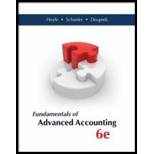
Concept explainers
Identify the correct option for the amount of cash that person B will receive before any of the other partners collect any cash.
Answer to Problem 9P
Option c. The amount of cash that person B will receive before any of the other partners collect any cash is $17,000.
Explanation of Solution
Calculate the amount of cash available:
Calculate the maximum allocated loss to each partner:
Now, find for all the other partners:
Now, find for partner B:
Now, find for partner J:
Person M shares a minimum amount of loss and is in the most feasible condition with 30% share and maximum allocated loss of $130,000.
Calculate the distribution of loss of $130,000 to all the partners
Now, loss to other partners
Loss distribution to all the partners
| Particulars | Person K | Person M | Person B | Person J |
| Beginning balance | $ 59,000 | $ 39,000 | $ 34,000 | $ 34,000 |
| Loss | $ (52,000) | $ (39,000) | $ (13,000) | $ (26,000) |
| Ending balance | $ 7,000 | $ - | $ 21,000 | $ 8,000 |
Table: (1)
Calculate maximum allocated loss to other three partners
Now, find for partner B
Now, find for partner J
Person K shares a minimum amount of loss and is in the most feasible condition with 40% share and maximum allocated loss of $12,250.
Calculate the distribution of loss of $12,250 to all the partners
Now, loss to other partners
Loss distribution to all the partners
| Particulars | Person K | Person B | Person J |
| Beginning balance | $ 7,000 | $ 21,000 | $ 8,000 |
| Loss | $ (7,000) | $ (1,750) | $ (3,500) |
| Ending balance | $ - | $ 19,250 | $ 4,500 |
Table: (2)
Calculate maximum allocated loss to other two partners
Now, find for partner J
Person J shares a minimum amount of loss and is in the most feasible condition with 20% share and maximum allocated loss of $6,750.
Calculate the distribution of loss of $6,750 to all the partners
Loss distribution to all the partners
| Particulars | Person B | Person J |
| Beginning balance | $ 19,250 | $ 4,500 |
| Loss | $ (2,250) | $ (4,500) |
| Ending balance | $ 17,000 | $ - |
Table: (3)
a.
$12,250 is the incorrect option because this is not the amount of cash that person B will receive before any of the other partners collect any cash.
b.
$14,750 is the incorrect option because this is not the amount of cash that person B will receive before any of the other partners collect any cash.
c.
$17,000 is the correct option because this is the amount of cash that person B will receive before any of the other partners collect any cash.
d.
$19,500 is the incorrect option because this is not the amount of cash that person B will receive before any of the other partners collect any cash.
Want to see more full solutions like this?
Chapter 10 Solutions
Fundamentals of Advanced Accounting
- Principles of Accounting Volume 1AccountingISBN:9781947172685Author:OpenStaxPublisher:OpenStax College
 Individual Income TaxesAccountingISBN:9780357109731Author:HoffmanPublisher:CENGAGE LEARNING - CONSIGNMENT
Individual Income TaxesAccountingISBN:9780357109731Author:HoffmanPublisher:CENGAGE LEARNING - CONSIGNMENT





